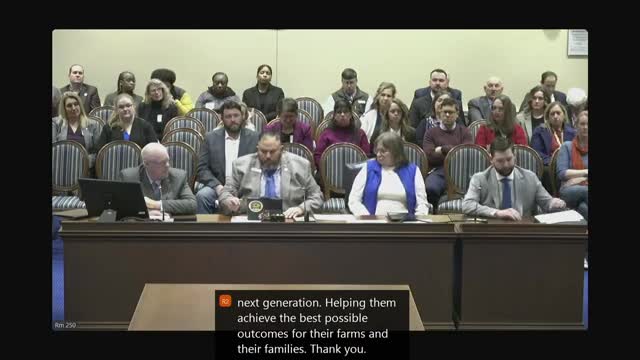Farmers urge limits on solar use of prime soils and more support for value-added agriculture
January 28, 2025 | Environment and Transportation Committee, HOUSE OF REPRESENTATIVES, Committees, Legislative, Maryland
This article was created by AI summarizing key points discussed. AI makes mistakes, so for full details and context, please refer to the video of the full meeting. Please report any errors so we can fix them. Report an error »

Carl Schlegel, a Farm Bureau board member representing southern Maryland, told the House Environment and Transportation Committee on Jan. 28 that protecting prime farmland is essential to food security and that solar installations should avoid Class 1 and 2 soils.
"We strongly oppose the placement of solar on prime agricultural soils," Schlegel said, urging use of publicly owned lands, brownfields, rooftops and parking lots before converting productive cropland. He acknowledged renewable energy goals but asked lawmakers to prevent a disproportionate burden on farms as the state pursues a 50% renewable target by 2031.
Panelists said solar can be an income stream on lower-quality fields and that some farmers use small-scale projects to offset energy costs. But several growers warned that 30-year project life cycles and construction practices that disturb topsoil can make it difficult or impossible to return land to agricultural use. "When you see the amount of topsoil that has moved...I have trouble believing that that field is ever gonna go back into agricultural production," Schlegel said.
Farmers also pressed for regulatory relief and support for value-added enterprises — from on-farm processing to agritourism — as ways to bolster farm profitability. One panelist described the state's ombudsman for value-added agriculture, housed in the Department of Agriculture, as a helpful resource and requested additional funding to expand the ombudsman's reach and services.
The committee heard no formal motions or votes on solar siting or value-added funding in this briefing; presenters and delegates discussed potential policy options and emphasized protecting topsoil and agricultural viability while meeting renewable energy goals.
"We strongly oppose the placement of solar on prime agricultural soils," Schlegel said, urging use of publicly owned lands, brownfields, rooftops and parking lots before converting productive cropland. He acknowledged renewable energy goals but asked lawmakers to prevent a disproportionate burden on farms as the state pursues a 50% renewable target by 2031.
Panelists said solar can be an income stream on lower-quality fields and that some farmers use small-scale projects to offset energy costs. But several growers warned that 30-year project life cycles and construction practices that disturb topsoil can make it difficult or impossible to return land to agricultural use. "When you see the amount of topsoil that has moved...I have trouble believing that that field is ever gonna go back into agricultural production," Schlegel said.
Farmers also pressed for regulatory relief and support for value-added enterprises — from on-farm processing to agritourism — as ways to bolster farm profitability. One panelist described the state's ombudsman for value-added agriculture, housed in the Department of Agriculture, as a helpful resource and requested additional funding to expand the ombudsman's reach and services.
The committee heard no formal motions or votes on solar siting or value-added funding in this briefing; presenters and delegates discussed potential policy options and emphasized protecting topsoil and agricultural viability while meeting renewable energy goals.
View full meeting
This article is based on a recent meeting—watch the full video and explore the complete transcript for deeper insights into the discussion.
View full meeting
